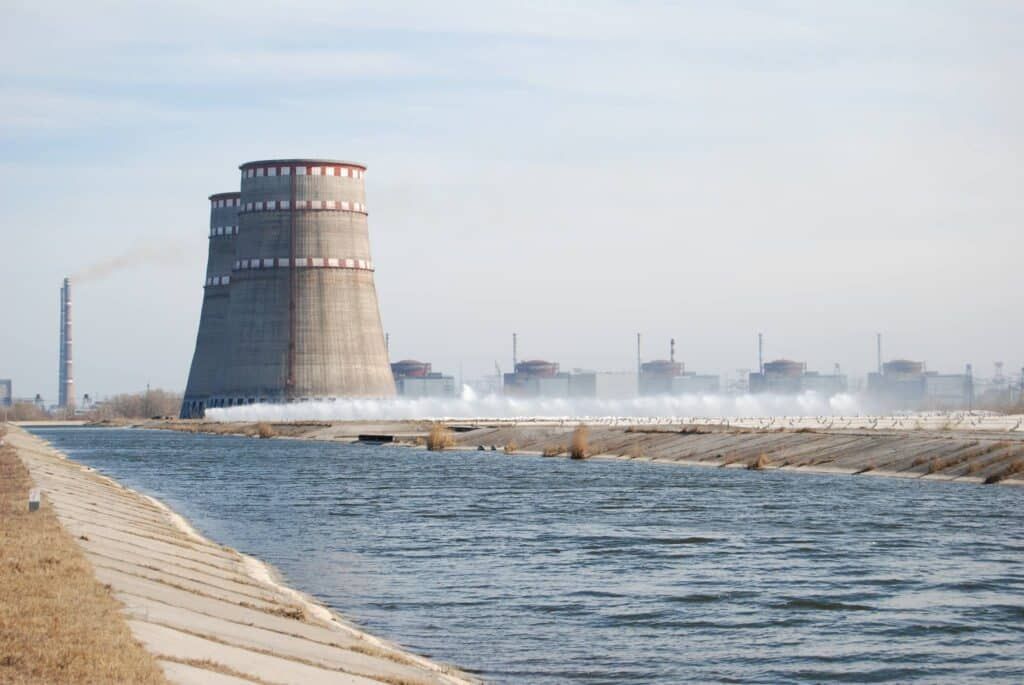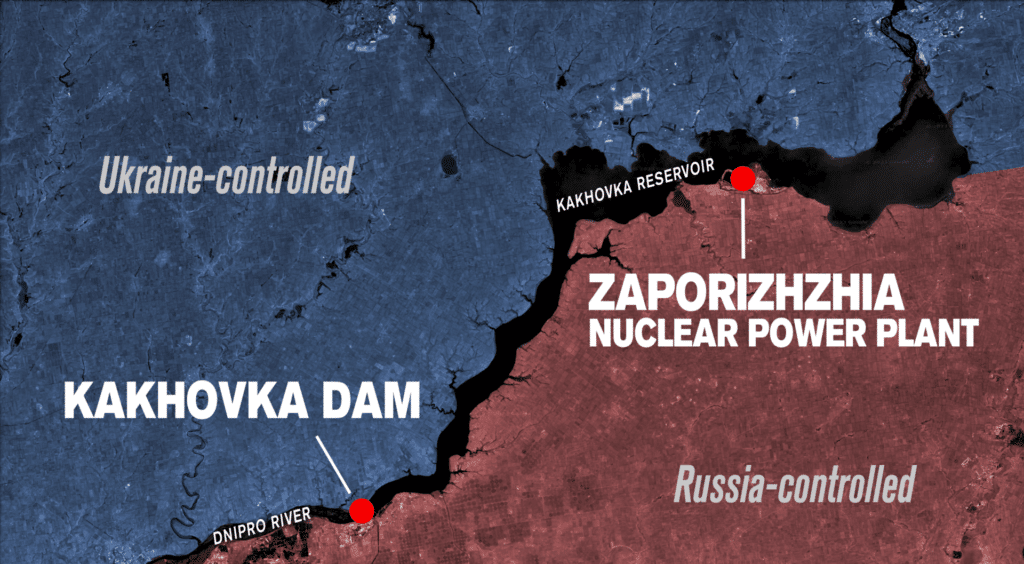Ukrainian dam is destroyed; nuclear plant lives in a ‘grace period’
By François Diaz-Maurin | June 6, 2023
 Cooling spray ponds at the Zaporizhzhia nuclear power plant. (Undated photo: Energoatom)
Cooling spray ponds at the Zaporizhzhia nuclear power plant. (Undated photo: Energoatom)
In the early hours of Tuesday, June 6, video footage circulated of a destroyed dam in southern Ukraine with large swaths of water flowing through. The Kakhovka dam—located about 70 kilometers upstream of the city of Kherson—is a critical piece of infrastructure, hosting a hydroelectric power plant and managing a reservoir that supplies water for drinking, irrigation, and cooling of the upstream six-reactor Zaporizhzhia nuclear power plant—Europe’s largest.
It was unclear on Tuesday what or who caused the breach in the dam, which is under Russian control, although it was hard not to blame Russia given the timing of the attack, which happened one day after Ukraine reportedly launched its long-awaited spring counteroffensive. Both countries denied responsibility and have blamed each other throughout the day. Ukraine said Russia was responsible for the explosion of an engine room of the hydroelectric plant, in part to prevent Ukrainian troops from crossing the Dnipro River downstream, while Russia said Ukrainian forces conducted a sabotage attack. Russia’s defense minister Sergei Shoigu made the acrobatic suggestion that because Ukraine wanted to transfer some military units and equipment from Kherson to other parts of the front to help with its counteroffensive, making the river wider downstream would make it easier to defend Kherson with fewer forces.
A third scenario being advanced on Tuesday was that the dam might have suffered from a structural failure after the water level of the Kakhovka reservoir had reached a 30-year high, leading it to be at beyond-design storage capacity since May. No evidence of any of those scenarios had emerged on Tuesday night, although Ukraine’s intelligence directorate reportedly said it had collected evidence that the hydroelectric plant had been destroyed using explosives, and US intelligence was also “leaning towards” Russia’s responsibility. In October 2022, Ukraine and Russia traded accusations of preparing attacks against the dam, with Ukraine warning that Russia had mined the dam and Russia responding the following day with the opposite suggestion.
The destruction of the dam caused immediate life-threatening flooding and evacuation of thousands of people living downstream of the dam along the Ukrainian-controlled right bank of the Dnipro River. Early satellite imagery was showing large areas being flooded a few hours only after the breach. While the water was quickly rising to dangerous levels downstream, the water level in the upstream Kakhovka Reservoir was dropping, which could have severe nuclear safety implications for the nearby plant.

The Kakhovka Reservoir serves as the Zaporizhzhia plant’s ultimate heat sink, an essential safety function of removing the radioactive decay heat generated by the fuel inside the shutdown reactors and spent fuel pools. The plant has a cooling pond that pumps its water from the Kakhovka Reservoir. According to the director general of the International Atomic Energy Agency (IAEA), Rafael Mariano Grossi, the water level of the Kakhovka Reservoir was dropping on Tuesday at a rate of 5 centimeters per hour, adding that “water in the reservoir was at around 16.4 meters at 8 am. If [it] drops below 12.7 meters, then it can no longer be pumped.” This would theoretically leave operators with about three days to pump as much water as possible to fill up the pond. But local Ukrainian military officials estimated that the water level was dropping at the much higher rate of about 15 centimeters per hour; leaving only 24 hours for the operators to do so.
Commenting on Twitter, Edwin Lyman, a nuclear safety expert at the Union of Concerned Scientists, described the situation at the Zaporizhzhia nuclear power plant as a “slow-motion disaster.” “The impact on the plant is something we are going to see unfold over time,” Lyman further explained to the Bulletin. “There is a grace period to address this problem, but it’s not infinite.”
In a statement, the American Nuclear Society was more reassuring: “Even if the water drops in the breached reservoir to pre-dammed levels for the Dnipro River, the nuclear plant has mobile pumping units that can be used to access water from alternative sources. The plant also has special floating water intakes which allow the facility to draw water when the reservoir is at low levels.” In his statement, Grossi said that the pond was sufficient to provide water for cooling for several months, although he added the IAEA will confirm this information.
Although the plant has not been generating electricity for several months and therefore requires less cooling than if its reactors were operating, before the dam’s breach on Tuesday, one reactor was apparently still in “hot shutdown” to produce steam for onsite purposes. “That means keeping an elevated pressure and temperature, [which] raises some questions about the stability of that reactor if something else happens,” Lyman explained. “It’s not a normal mode of operating a nuclear reactor. And, because it’s not a normal mode, normal emergency procedures may not be available if something goes wrong.”
Since February 2022, the Russia-Ukraine war has had devastating consequences on Ukraine’s water resources and infrastructure. But with the destruction of the Kakhovka dam on Tuesday, another safety layer vanished. In his statement, Grossi said that there was “no immediate risk to the safety of the plant.” But that is “assuming nothing else happens,” Lyman told the Bulletin. “The plant is stable for now, but it is becoming increasingly more vulnerable.” Grossi conceded that “it is vital that this cooling pond remains intact.”
“Nothing must be done to potentially undermine its integrity.”
Together, we make the world safer.
The Bulletin elevates expert voices above the noise. But as an independent nonprofit organization, our operations depend on the support of readers like you. Help us continue to deliver quality journalism that holds leaders accountable. Your support of our work at any level is important. In return, we promise our coverage will be understandable, influential, vigilant, solution-oriented, and fair-minded. Together we can make a difference.















Thank you, BoAS and UCS. Mainstream media is providing essential no serious coverage of this slow motion train wreck. The NY Times and the Guardian actually reported the NPP as being 200km DOWNstream of the dam!
Please keep your sharp eyes on this for all of us. And please include info on the consequences of a failure to cool the copious spent fuel. Roughly speaking, they would make the downstream flood look like an amusement waterpark.
What is the worst case scenario for this disaster? Will it be worse than Fukushima and Chernobyl?
Let’s not allow our geopolitical predilections to influence something as important as the safety of a nuclear power plant.